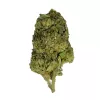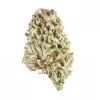Humulene, a terpene with a unique profile and potential therapeutic properties, has piqued the curiosity of those exploring the world of natural compounds.
In this article, we dive into the frequently asked questions about humulene, its diverse effects, and its presence in various botanical sources. From its molecular structure to its potential impacts on health and wellness, we'll uncover the essential aspects of this intriguing compound.
What is the Humulene Terpene?
Humulene is a sesquiterpene that can be commonly found in the essential oils of various plants, contributing to their distinct aromas and potential therapeutic properties.
This terpene's name is derived from the hops plant, scientifically known as Humulus lupulus, which is famous for its use in brewing beer. Humulene shares its aromatic traits with this plant, along with a range of other botanical sources, including herbs and spices.
Humulene's aromatic influence is not limited to the hops plant. It's widely distributed throughout the plant kingdom and can be found in herbs like basil and sage, as well as spices like clove.
The intriguing part is that humulene is present in both hops and cannabis, both of which belong to the Cannabaceae family. This shared presence highlights the terpene's ability to provide similar scent profiles to vastly different plants, showcasing its versatility in nature.
In addition to its aromatic contributions, humulene has also piqued the interest of researchers due to its potential health benefits. Its antibacterial, anti-inflammatory, and even appetite-suppressing properties have been investigated, expanding the terpene's significance beyond its fragrance.
Thus, humulene emerges as a multi-faceted compound that not only enriches the world of scents but also holds promise in the realm of holistic and biomedical applications.

What Does the Humulene Terpene Do?
Studies have indicated that humulene possesses antibacterial properties, particularly against the bacterium Staphylococcus aureus. This bacterium is known for causing infections and can lead to various diseases.
Humulene's ability to combat Staphylococcus aureus showcases its potential as a natural antibacterial agent. This property underscores the age-old use of humulene-rich essential oils in traditional healing practices.
In the context of cannabis plants, humulene takes on a vital role in the plant's defense mechanisms. Together with other terpenes, it aids in deterring pests and preventing fungal infestations. This defense strategy is crucial for the plant's survival and overall health, highlighting the multifunctional nature of humulene in the natural world.
Sources of Humulene: From Hops to Cannabis and Beyond
There are many things that have humulene strains on the composition, the most common ones are:
|
Type |
Description |
Additional Information |
|---|---|---|
|
Hops |
Humulene is one of the essential oils found in hops, giving beer its distinct flavor. |
Provides bitterness and earthy, herbal notes to beer. |
|
Cannabis |
Humulene is one of the primary terpenes found in cannabis, especially in sativa strains. |
Can provide anti-inflammatory and appetite suppressing effects. |
|
Cloves |
Contains high levels of humulene, contributing to the spice's flavor. |
Gives cloves their warm, earthy aroma and flavor. |
|
Basil |
An herb that contains moderate amounts of humulene. |
Adds a woody, spicy component to basil's flavor profile. |
|
Ginger |
Ginger essential oil has traces of humulene. |
Contributes an earthy undertone to ginger's bright, sharp flavor. |
|
Sage |
An aromatic herb with humulene in its essential oil. |
Humulene adds to sage's woodsy, herbal scent and taste. |
The Role and Effects of the Humulene Terpene
The world of cannabis aroma owes much of its distinctiveness to terpenes, and among them, humulene stands out. With its earthy and woody scent, humulene is found not only in cannabis plants but also in various herbs and flowers.
This terpene holds a prominent spot among the 100+ terpenes found in cannabis, contributing to its unique aroma profile.
Humulene plays a pivotal role in shaping the sensory experience of cannabis and hops alike. Its earthy and woody aroma resonates with beer enthusiasts as the contributor to the "hoppy" bitterness in craft brews.
This scent is easily recognizable, particularly to those familiar with brewery environments or the nuanced world of craft beers. The versatility of humulene extends beyond its aromatic properties, however, as its effects and benefits have gained attention in both traditional and modern contexts.
Studies into humulene's effects have uncovered its potential impact on diverse aspects of human health. While it doesn't interact with CB receptors like cannabinoids, it has shown the ability to trigger several effects within the body.
Humulene benefits, it displays anti-inflammatory and anti-pain properties, potentially offering relief to those dealing with discomfort.
Humulene’s potential benefits include:
-
Anti-inflammatory and pain relief effects
-
Antibacterial capabilities
-
Appetite-suppressant qualities
-
Contribution to the entourage effect
-
Therapeutic advantages for chronic conditions
-
Assistance in weight loss and eating disorders management
Humulene in Nature and Botanical Sources
Within the realm of cannabis, the humulene terpene takes on a crucial role in shaping both the aroma and potential effects of various strains. This natural compound contributes to the captivating scent of cannabis, intermingling earthy, woody, and slightly spicy notes.
But its significance extends beyond fragrance, as humulene brings forth a range of potential effects that can influence the overall experience of consuming cannabis.
Humulene contributes to the complex bouquet of cannabis strains, adding depth and character to their olfactory profiles. Its earthy and woody scent, often accompanied by a hint of spice, provides a foundational layer to the aromatic composition of different strains.
This aromatic signature not only distinguishes strains containing humulene but also adds to the overall sensory appeal of cannabis consumption. While terpenes like humulene don't interact directly with the endocannabinoid system like cannabinoids do, they can still contribute to the overall effects of cannabis consumption.
Humulene's potential anti-inflammatory, antibacterial, and appetite-suppressant properties align with the therapeutic effects often sought from cannabis.
Its presence within strains could enhance pain relief, reduce inflammation, and potentially contribute to the entourage effect, where terpenes and cannabinoids synergistically amplify each other's effects.

What is the Humulene Terpene in Weed?
Humulene terpene is a natural compound found within cannabis, contributing to both its distinctive aroma and potential effects. This terpene, also present in other plants like hops, herbs, and flowers, adds complexity and depth to the sensory experience of consuming cannabis.
Understanding humulene's presence in weed involves delving into its aromatic qualities and its potential impact on the overall cannabis experience.
Is Humulene Polar or Non-Polar?
Humulene is considered a non-polar terpene. Polar molecules have positive and negative charge regions due to differences in electronegativity between atoms, causing them to interact with other polar substances. In contrast, non-polar molecules lack distinct positive or negative areas and tend to interact more with other non-polar molecules.
Humulene's molecular structure lacks significant polarity, as it consists primarily of carbon and hydrogen atoms bonded together. This non-polar nature contributes to its compatibility with other non-polar compounds, such as lipids and oils, which are commonly found in the cannabis plant and other natural sources.
Is the Humulene Terpene Safe?
Humulene terpene is generally considered safe for consumption and use. It is a naturally occurring compound found in various plants, including cannabis, hops, and herbs. Humulene has been used for centuries in traditional medicine practices and is a common ingredient in therapeutic-grade essential oils.
When consumed in moderate amounts through sources like cannabis strains or herbal extracts, humulene is unlikely to cause significant adverse effects.
However, as with any natural compound, individual sensitivities can vary, and some individuals might experience mild allergic reactions or sensitivities. It's always a good practice to start with small amounts and observe your body's response.
It's worth noting that humulene is commonly found in hops, which are a key ingredient in beer production. Therefore, people who enjoy beer are likely to have been exposed to humulene through this avenue without adverse effects.

Health Benefits of Humulene
Humulene terpene has garnered attention for its potential to provide a range of health benefits. While individual responses can vary, scientific research has highlighted several promising areas where humulene may contribute positively to overall well-being
One of the notable attributes of humulene is its anti-inflammatory properties. By potentially targeting specific pathways and enzymes associated with inflammation, this terpene could offer relief for individuals dealing with chronic inflammatory conditions.
Studies suggest that humulene exhibits antibacterial activity against certain strains of bacteria. This suggests potential applications in supporting the body's defense against harmful bacteria and infections.
While ongoing research continues to unveil humulene's potential health benefits, it's essential to approach these findings with a balanced perspective. Consulting healthcare professionals before making significant changes to one's health regimen is always recommended.
Humulene and Inflammation
Inflammation has been linked to various mental health conditions. Given humulene's anti-inflammatory properties, it could indirectly impact mental well-being by mitigating inflammation that might contribute to certain cognitive and emotional challenges.
Furthermore, humulene's potential neuroprotective effects could aid in preserving brain health, potentially supporting cognitive function and emotional resilience.
As part of the entourage effect, humulene collaborates with other terpenes and cannabinoids to enhance their effects. This synergy could extend to mental well-being, potentially promoting a balanced and harmonious state of mind.
While it's essential to approach these findings with caution and consult professionals when seeking to address mental health concerns, the potential of humulene to contribute to a holistic approach to well-being is an area of growing interest.
Does Humulene Cause Anxiety?
Humulene's anti-inflammatory and neuroprotective properties could indirectly impact anxiety by influencing stress-related pathways in the brain.
By mitigating inflammation and promoting brain health, humulene might contribute to a more resilient response to stressors, potentially aiding in anxiety management.
Sensory Experience: How Does Humulene Make You Feel?
Humulene, a terpene found in various plants including hops and cannabis, can contribute to a range of sensory experiences and potential effects. Its aroma is often described as earthy, woody, and spicy, with hints of herbal and hoppy notes. While terpenes like humulene don't produce the same psychoactive effects as cannabinoids, they can influence the overall experience and effects of a particular cannabis strain.
But it's not just about the smell. Humulene's potential effects can also contribute to your overall sense of well-being. Whether you're using it to set the mood, ease stress, or simply enjoy its delightful aroma, Humulene is like a little bottle of happiness.

Aromatic Presence: How Humulene Shapes Sensory Experiences
Humulene's aromatic signature is characterized by earthy and woody notes, with subtle hints of spice. This intricate blend of scents creates a sensory journey that evokes connections with nature and the outdoors.
As you explore strains rich in humulene, you're greeted by an essence reminiscent of forests, fields, and the raw beauty of the natural world.
Within the realm of cannabis, humulene plays a crucial role in enhancing strain diversity. Its presence contributes to the myriad of fragrances that distinguish one strain from another, influencing consumers' preferences and choices.
The earthy and woody undertones provided by humulene join forces with other terpenes and cannabinoids to create a symphony of scents that define each strain's identity.
How Many Hydrogens Are in Humulene?
The Humulene structure is C15H24, indicating that it is composed of 15 carbon atoms (C) and 24 hydrogen atoms (H). This arrangement forms a backbone that, in combination with the carbon atoms and their connections, gives humulene its distinctive properties.
The presence of hydrogen atoms in humulene contributes to its overall chemical reactivity and behavior. The distribution and arrangement of hydrogen atoms within the molecular structure influence how humulene interacts with other compounds and receptors in various contexts, such as its potential effects on human health and well-being.
Handling and Toxicity
Too much humulene might cause some stomach discomfort, so it's best to stick to recommended dosages. As with any natural compound, it's always a good idea to have a chat with your healthcare pro before diving headfirst into a humulene adventure.
Is Humulene Toxic?
The good news is that humulene is generally safe for most folks when used as intended.
Is Humulene Flammable?
Humulene is considered flammable, so it's a good idea to keep it away from open flames and high heat.
The Final Scoop on Humulene
Humulene, a terpene with its unique aroma and potential health-enhancing properties, continues to intrigue researchers and wellness enthusiasts. Its presence in various plants and its potential effects on inflammation and appetite make it a subject of significant interest.
As scientific exploration advances, our understanding of humulene's effects and applications deepens, revealing its potential to contribute to sensory experiences and holistic well-being.










